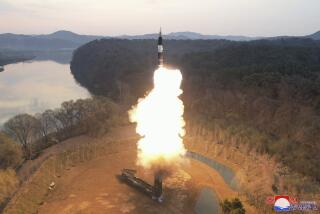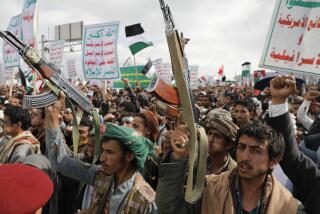Suspect Vessel Eludes U.S. Net, Docks in Iran
- Share via
WASHINGTON — A North Korean cargo vessel believed to be carrying advanced Scud missiles to Iran and Syria slipped past a gantlet of 22 U.S. warships in and around the Arabian Sea and anchored in the Iranian port of Bandar Abbas, defense officials said Tuesday.
The ship’s success at eluding U.S. surveillance embarrassed American officials and frustrated their controversial plan to intercept--and perhaps board--the North Korean ship on the grounds that it could be trying to violate an international trade embargo of Iraq.
After monitoring the ship’s progress from North Korea for more than two weeks, the U.S. Navy discovered Tuesday by satellite surveillance that the vessel, the Dae Hong Ho, had passed through the Strait of Hormuz, which is 30 miles wide at its narrowest point, and was in port.
Defense officials said that there are “indications” the ship may have eluded the U.S. warships by hugging the coastline of Iran--and perhaps of Pakistan and India.
Pentagon spokesman Pete Williams also said Tuesday that a few weeks ago, the U.S. naval armada in the Persian Gulf challenged an Iranian ship that had left North Korea earlier. In response to a query from the U.S. Navy destroyer Ingersoll, the ship--the Iran Salaam--replied that it was carrying drilling equipment and steel to Iran. It was permitted to pass.
The incident with the Dae Hong Ho cost the United States an opportunity to demonstrate decisively that North Korea is continuing to supply missile technology to the region, despite the Koreans’ denials. At the same time, however, it spares the United States having to decide what to do with that proof.
Had the ship carried missiles--but also proper documents reflecting that--the Navy would have had to let the ship proceed, since it does not have authority to stop trade with Iran. If the ship’s documents misrepresented its cargo or its destination, the United States could have turned it away. But it then would have had to defend to skeptical Persian Gulf allies its decision to use the naval embargo of Iraq to stop a ship headed for Iraq’s old enemy, Iran.
Believing because of intelligence reports that North Korean Scuds have been delivered to the volatile Middle East, the United States is now confronted with a host of new problems. The missiles, with their range of about 300 miles, would give Iran for the first time the ability to target all of Saudi Arabia’s oil-producing Eastern Province and Iraq’s southern cities, experts said. Iran already has vast stockpiles of chemical weapons.
If Syria receives some of the new Scuds--a transfer that could be made by air from Iran--experts said that the Syrians would be able to target virtually all of Israel. The resulting arsenal of missiles would be too numerous and could be too widely dispersed throughout Syria for Israeli forces to eliminate the missiles in any preemptive strike.
Syria has had earlier generations of Scud missiles, with shorter ranges and less accuracy. But the apparent arrival of the longer-range Scud missiles would mark a new development in Iran’s arsenal. For both countries, experts said, the North Korean technical assistance that comes with the weapons could be crucial in the development of even more lethal chemical and biological warheads than those in Syria’s and Iran’s current inventories.
The regional upheaval that is likely to result would put greater pressure on the United States to increase its arms sales to the Middle East and could accelerate a race to develop and stockpile weapons of mass destruction.
Since the late 1980s, Syria and Iran have cooperated loosely in the development of chemical and biological arms, according to Middle East security analyst Anthony Cordesman of Georgetown University.
“It makes arms control or any kind of regional peace agreements more difficult. And it raises the specter that the countries of the Middle East will shift from a conventional arms race to one of weapons of mass destruction,” he said. “In this region, there is no delicate balance of terror. It’s an indelicate balance of war.”
Such concerns led Bush Administration officials to warn--as the Dae Hong Ho approached the Arabian Sea--that it would use the U.N. naval embargo on trade with Iraq either to stop or expose the North Korean arms sale.
Many independent analysts questioned the wisdom of the Administration’s threat to use a U.S. warship while claiming authority under a U.N. resolution to challenge the delivery of arms to Iran.
But in late February, as the Dae Hong Ho rounded the tip of India, the Pentagon dispatched a P-3 Orion aircraft and a Navy cruiser to find the ship. American intelligence agencies were ordered to use photo reconnaissance satellites to plot the ship’s position several times a day.
Knowledgeable Pentagon sources said that at least one of the Navy’s land-based P-3 aircraft, designed to scan the oceans for submarines, located the North Korean vessel in recent days. But the planes do not have the cruising power to stay with the ship, and subsequent P-3 patrols were unable to locate it.
The U.S. Navy cruiser, which could have fallen in behind the vessel and shadowed it into the Persian Gulf, never located the North Korean ship. It is not clear whether U.S. satellites were able to find the vessel in a vast ocean area dense with commercial traffic.
As the hunt for the Dae Hong Ho accelerated, naval officials in the Persian Gulf asked to shift additional ships and planes to the task of tracking and intercepting the ship. A senior defense official said that the request was denied when top military officers at the Pentagon decided that the Navy had devoted enough resources to the task.
“It was not a full-court press,” said one senior Pentagon official. “We didn’t want to divert everything to intercept the ship. The purpose of the intercept operation is to stop trade to Iraq, after all.”
More to Read
Sign up for Essential California
The most important California stories and recommendations in your inbox every morning.
You may occasionally receive promotional content from the Los Angeles Times.














